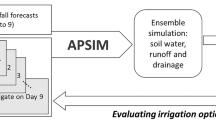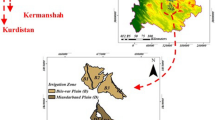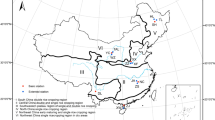Abstract
Weather forecasts can enhance the utilization of scientific irrigation scheduling tools, crucial for maximizing agricultural water use efficiency. This study employed quantitative weather forecasts of 3-, 7- and 14-day lead times from a weather application programming interface (API) to generate irrigation schedules using the AquaCrop-OSPy model for maize, cotton and sorghum under different regulated deficit irrigation scenarios. The study aimed to determine the suitability of forecast lengths for irrigation scheduling under varying pumping capacities of center pivots (114 m3h−1, 182 m3 h−1 and 250 m3 h−1) in the Texas High Plains and Rio Grande Basin regions, United States. A comparative analysis was carried out to evaluate the irrigation schedules and corresponding crop yields simulated using forecasted and observed weather data. Results indicated that using shorter forecast time allowed the crop model to capture more precise variations in weather patterns, however, shorter lead times also caused over-irrigation in some scenarios. Use of longer lead times tended to be less suitable for scheduling irrigation during water-sensitive growth stages. Center pivots with large pumping capacities and application rates benefited more from longer forecast lengths due to their ability to adapt to weather fluctuations. Unplanned irrigation application occurred in some instances, primarily attributed to uncertainties in weather forecasts and limitations of the crop model. The approach developed and evaluated in this study supports water conservation efforts by promoting scientific irrigation scheduling in weather-data-poor and low adoption regions.











Similar content being viewed by others
Data availability
Data available on request from the authors.
References
Abatzoglou JT (2013) Development of gridded surface meteorological data for ecological applications and modelling. Int J Climatol 33(1):121–131
Ahmed S, Habib M. A, Rasul MG (2021) Development of a machine learning-based model for irrigation scheduling of wheat using weather forecast data. Comput Electron Agric 186
Alderman PD (2020) A comprehensive R interface for the DSSAT cropping systems model. Comput Electron Agric 172:105325
Ale S, Omani N, Himanshu SK, Bordovsky JP, Thorp KR, Barnes EM (2020) Determining optimum irrigation termination periods for cotton production in the Texas High Plains. Trans ASABE 63(1):105–115
Allen RG (2016) REF-ET: Reference evapotranspiration calculator, Version 4.1, Idaho University: Moscow, ID, USA, 2015; Available online: https://www.uidaho.edu/cals/kimberly-research-and-extension-center/research/water-resources/ref-et-software (accessed on 21 Nov 2021)
Asadi ME, Kouchakzadeh M, Behboudian MH, Bondada BR (2019) Forecast-based irrigation scheduling improves water use efficiency and yield of pistachio. Agric Water Manag 212:146–154
Baigorria GA, Chelliah M, Mo KC, Romero CC, Jones JW, O’Brien JJ, Higgins RW (2010) Forecasting cotton yield in the southeastern United States using coupled global circulation models. Agron J 102(1):187–196
Basso B, Liu L (2019) Seasonal crop yield forecast: methods, applications, and accuracies. Advances in agronomy. Elsevier, pp 201–255
Baumhardt RL, Staggenborg SA, Gowda PH, Colaizzi PD, Howell TA (2009) Modeling irrigation management strategies to maximize cotton lint yield and water use efficiency. Agron J 101(3):460–468
Bell JM, Schwartz R, McInnes KJ, Howell T, Morgan CL (2018) Deficit irrigation effects on yield and yield components of grain sorghum. Agric Water Manag 203:289–296
Benavidez J, Guerrero B, Dudensing R, Jones D, Reynolds S (2019) The impact of agri business in the high plains trade area (https://amarillo.tamu.edu/files/2019/12/Impact-of-AgriBusiness.pdf)
Bergez JE, Garcia F (2010) Is it worth using short-term weather forecasts for irrigation management? Eur J Agron 33(3):175–181
Berthold TA, Ajaz A, Olsovsky T, Kathuria D (2021) Identifying barriers to adoption of irrigation scheduling tools in Rio Grande Basin. Smart Agric Tech 1:100016
Cai X, Hejazi MI, Wang D (2011) Value of probabilistic weather forecasts: assessment by real-time optimization of irrigation scheduling. J Water Resour Plan Manag 137(5):391–403
Cantelaube P, Terres JM (2005) Seasonal weather forecasts for crop yield modelling in Europe. Tellus A Dyn Meteorol Oceanogr 57(3):476–487
Caron JF, Buehner M (2022) Implementation of scale-dependent background-error covariance localization in the canadian global deterministic prediction system. Weather Forecast 37(9):1567–1580
Carr T, Yang H, Ray C (2016) Temporal variations of water productivity in irrigated corn: an analysis of factors influencing yield and water use across central Nebraska. PLoS ONE 11(8):e0161944
Personal Communication (2021) Multiple meetings and extension outreach events including general managers and irrigations of groundwater conservation districts spread across Ogallala aquifer (Texas and New Mexico)
Cruz RB, Contreras-Soto RI, Pérez-Muñoz FD, Guzmán JG (2021) Optimal irrigation scheduling based on a stochastic optimization model using historical and forecasted weather data for maize crops. Agric Water Manag, 244
Domínguez A, Schwartz RC, Pardo JJ, Guerrero B, Bell JM, Colaizzi PD, Baumhardt RL (2022) Center pivot irrigation capacity effects on maize yield and profitability in the Texas High Plains. Agric Water Manag 261:107335
Farré I, Faci JM (2006) Comparative response of maize (Zea mays L.) and sorghum (Sorghum bicolor L. Moench) to deficit irrigation in a mediterranean environment. Agric Water Manag 83(1–2):135–143
Guo D, Wang QJ, Ryu D, Yang Q, Moller P, Western AW (2023) An analysis framework to evaluate irrigation decisions using short-term ensemble weather forecasts. Irrig Sci 41(1):155–171
Hameed A, Ali T, Ali Q, Saleem M (2020) Improved maize productivity through weather-based irrigation scheduling. J Irrigation Drain Eng, 146(1)
Hamill TM, Engle E, Myrick D, Peroutka M, Finan C, Scheuerer M (2017) The US national blend of models for statistical postprocessing of probability of precipitation and deterministic precipitation amount. Mon Weather Rev 145(9):3441–3463
Heng LK, Hsiao T, Evett S, Howell T, Steduto P (2009) Validating the FAO AquaCrop model for irrigated and water deficient field maize. Agron J 101(3):488–498
Hennon CC, Coleman A, Hill A (2022) Short-term weather forecast skill of artificial neural networks. Weather Forecast 37(10):1941–1951
Himanshu SK, Ale S, Bordovsky J, Darapuneni M (2019) Evaluation of crop-growth-stage-based deficit irrigation strategies for cotton production in the Southern High Plains. Agric Water Manag 225:105782
Hintz KS, O’BoyleDanceAl-AliAnsperBlaauboerYang KSLSIDX (2019) Collecting and utilising crowdsourced data for numerical weather prediction: propositions from the meeting held in copenhagen. Atmos Sci Lett 20(7):e921
Jiang W, Thapa S, Jessup KE, Hao B, Hou X, Marek T, Xue Q (2020) Corn response to later than traditional planting dates in the Texas High Plains. Crop Sci 60(2):1004–1020
Karamitsou T, Seventekidis D, Karapiperis C, Banti K, Karampelia I, Kyriakidis T, Louta M (2022) Open weather data evaluation for crop irrigation prediction mechanisms in the AUGEIAS project. In 2022 7th South-East Europe Design Automation, Computer Engineering, Computer Networks and Social Media Conference (SEEDA-CECNSM) (pp. 1–4). IEEE
Kelly TD, Foster T (2021) AquaCrop-OSPy: bridging the gap between research and practice in crop-water modeling. Agric Water Manag 254:106976
Kephe PN, Ayisi KK, Petja BM (2021) Challenges and opportunities in crop simulation modelling under seasonal and projected climate change scenarios for crop production in South Africa. Agric Food Secur 10(1):1–24
Kinzli KD, Manana N, Oad R (2012) Comparison of laboratory and field calibration of a soil-moisture capacitance probe for various soils. J Irrig Drain Eng 138(4):310–321
Kirda C (2002) Deficit irrigation scheduling based on plant growth stages showing water stress tolerance. Food and agricultural organization of the United Nations, Deficit irrigation practices, Water Rep, 22(102).
Klocke NL, Currie RS, Tomsicek DJ, Koehn J (2011) Corn yield response to deficit irrigation. Trans ASABE 54(3):931–940
Krennert T, Pistotnik G, Kaltenberger R, Csekits C (2018) Crowdsourcing of weather observations at national meteorological and hydrological services in Europe. Adv Sci Res 15:71–76
Kusunose Y, Mahmood R (2016) Imperfect forecasts and decision making in agriculture. Agric Syst 146:103–110
Lesikar B, Kaiser R, Silvy V (2002) Questions about groundwater conservation districts in Texas. Available online. https://www.landcan.org/pdfs/GW-Conserv-Dist.pdf. Accessed 02/08/2021
Linker R, Sylaios G, Tsakmakis I, Ramos T, Simionesei L, Plauborg F, Battilani A (2018) Sub-optimal model-based deficit irrigation scheduling with realistic weather forecasts. Irrig Sci 36:349–362
Lorite IJ, Ramírez-Cuesta JM, Cruz-Blanco M, Santos C (2015) Using weather forecast data for irrigation scheduling under semi-arid conditions. Irrig Sci 33:411–427
Lucas Segarra E, Du H, Ramos Ruiz G, Fernández Bandera C (2019) Methodology for the quantification of the impact of weather forecasts in predictive simulation models. Energies 12(7):1309
Main CL (2012) Cotton growth and development. Univ Tenn Ext Bull W 287:12–0108
Maqbool S, Anjum MA, Iqbal A (2020) Forecasting irrigation water requirements using numerical weather prediction models and machine learning techniques. J Irrig Drainage Eng 146(2)
Marek TH, Porter D, Howell T (2005) The Texas high plains evapotranspiration network: an irrigation scheduling technology transfer tool. Irrig Water Qual Res Rep, 358–8
Masasi B, Taghvaeian S, Boman R, Datta S (2019a) Impacts of irrigation termination date on cotton yield and irrigation requirement. Agriculture 9(2):39
Masasi B, Taghvaeian S, Gowda PH, Warren J, Marek G (2019b) Simulating soil water content, evapotranspiration, and yield of variably irrigated grain sorghum using AquaCrop. JAWRA J Am Water Res Assoc 55(4):976–993
Masasi B, Taghvaeian S, Gowda PH, Marek G, Boman R (2020) Validation and application of AquaCrop for irrigated cotton in the Southern Great Plains of US. Irrig Sci 38(5):593–607
Mastrorilli M, Katerji N, Rana G (1995) Water efficiency and stress on grain sorghum at different reproductive stages. Agric Water Manag 28(1):23–34
McCorkle TA, Williams SS, Pfeiffer TA, Basara JB (2016) Atmospheric contributors to heavy rainfall events in the Arkansas-red river Basin. Adv Meteorol 2016:1–15
Miller K, Milman A, Burson M, Tracy J, Kiparsky M (2021) Groundwater recharge for drought and endangered species protection: the H2Oaks Aquifer to Aquifer transfer for storage and recovery, san antonio. Texas Case Stud Environ 5(1):1118198
New L, Fipps G (2000) Center pivot irrigation. Texas Agricultural Extension Service B-6096. Available electronically from https://hdl.handle.net/1969.1/86877
New Mexico Irrigation Center (2017) Crop Resources. https://aces.nmsu.edu/aes/irrigation/index.html
O’Shaughnessy SA, Kim M, Andrade MA, Colaizzi PD, Evett SR (2020) Site-specific irrigation of grain sorghum using plant and soil water sensing feedback-Texas High Plains. Agric Water Manage 240:106273
Pauley PM, Ingleby B (2022) Assimilation of in-situ observations. Data Assimilation for Atmospheric, Oceanic and Hydrologic Applications. Springer, Cham, pp 293–371
Pereira LS, Paredes P, Jovanovic N (2020) Soil water balance models for determining crop water and irrigation requirements and irrigation scheduling focusing on the FAO56 method and the dual Kc approach. Agric Water Manag 241:106357
Piccinni G, Ko J, Marek T, Howell T (2009) Determination of growth-stage-specific crop coefficients (KC) of maize and sorghum. Agric Water Manag 96(12):1698–1704
Ritchie GL, Bednarz CW, Jost PH, Brown SM (2007) Cotton growth and development. University of Georgia
Rodriguez SP (2021) The Impact of Drought on Agriculture in New Mexico. (https://digitalrepository.unm.edu/cgi/viewcontent.cgi?article=1016&context=hsc_climate)
Ruiz-Sánchez MC, Rodríguez-Díaz JA, Camps Arbestain M, Pastor M (2018) Combining historical and forecasted meteorological data to optimize irrigation scheduling in avocado (Persea americana Mill.). Irrig Sci 36(3):225–237
Saddique Q, Cai H, Xu J, Ajaz A, He J, Yu Q, He L (2020) Analyzing adaptation strategies for maize production under future climate change in Guanzhong Plain, China. Mitig Adaptation Strateg Glob Change 25(8):1523–1543
Sangha L, Shortridge J, Frame W (2023) The impact of nitrogen treatment and short-term weather forecast data in irrigation scheduling of corn and cotton on water and nutrient use efficiency in humid climates. Agric Water Manag 283:108314
Sawan ZM, Hanna LI, McCuistions WL (2006) Appropriate time scale for aggregating climatic data to predict flowering and boll setting behaviour of cotton in Egypt. Commun Biom Crop Sci 1:11–19
Soil Survey Staff (2022) Natural resources conservation service, United States Department of Agriculture. Soil survey geographic (SSURGO) Database for Texas. Available online. Accessed 02/08/2021
Steduto P, Hsiao TC, Raes D, Fereres E (2009) AquaCrop—The FAO crop model to simulate yield response to water: I. Concepts Underlying Princ Agron J 101(3):426–437
Taghvaeian S, Andales AA, Allen LN, KisekkaI I, O’Shaughnessy SA, Porter DO, Aguilar J (2020) Irrigation scheduling for agriculture in the United States: the progress made and the path forward. Trans ASABE 63(5):1603–1618
Terrell BL, Johnson PN, Segarra E (2002) Ogallala aquifer depletion: economic impact on the Texas high plains. Water Policy 4(1):33–46
TexasET (2023) TexasET Network. About TexasET. Retrieved from https://texaset.tamu.edu/Home/About
Togliatti K, Archontoulis SV, Dietzel R, Puntel L, VanLoocke A (2017) How does inclusion of weather forecasting impact in-season crop model predictions? Field Crop Res 214:261–272
USDA (2020) National Agricultural Statistics Service Cropland Data Layer. Published crop-specific data layer [Online]. Available at https://nassgeodata.gmu.edu/CropScape/. USDA-NASS, Washington, DC
Visual Crossing Corporation (2023). Visual Crossing Weather, Weather Data Documentation. Retrieved from https://www.visualcrossing.com/
Wang D, Cai X (2009) Irrigation scheduling—role of weather forecasting and farmers’ behavior. J Water Resour Plan Manag 135(5):364–372
Ward FA, Michelsen AM, DeMouche L (2007) Barriers to water conservation in the Rio Grande Basin 1. JAWRA J Am Water Res Assoc 43(1):237–253
Zhang H, Han M, Comas LH, DeJonge KC, Gleason SM, Trout TJ, Ma L (2019) Response of maize yield components to growth stage-based deficit irrigation. Agron J 111(6):3244–3252
Acknowledgements
Funding for this project is provided by USDA to Project No. 2017–68007-26318, through the National Institute of Food and Agriculture’s Agriculture and Food Research Initiative. The authors are thankful to Kirk E. Jessup from Texas A&M AgriLife Research, Amarillo, TX, for sharing the experimental data for model calibration.
Funding
This study was supported by National Institute of Food and Agriculture, 2017-68007-26318, 2017-68007-26318.
Author information
Authors and Affiliations
Contributions
AA: manuscript text, major analysis, programming script; AB: manuscript text, funding; QX: data, review; SJ: review, programming script, BM: calibrated models; QS: review, analysis.
Corresponding author
Ethics declarations
Conflict of interest
The authors declare no competing interests.
Additional information
Publisher's Note
Springer Nature remains neutral with regard to jurisdictional claims in published maps and institutional affiliations.
Supplementary Information
Below is the link to the electronic supplementary material.
271_2023_881_MOESM1_ESM.docx
Long term (1991–2020) monthly averages of precipitation (PPT), reference evapotranspiration (ETo), and mean temperature (TEMP). Supplementary file1 (DOCX 18 KB)
Rights and permissions
Springer Nature or its licensor (e.g. a society or other partner) holds exclusive rights to this article under a publishing agreement with the author(s) or other rightsholder(s); author self-archiving of the accepted manuscript version of this article is solely governed by the terms of such publishing agreement and applicable law.
About this article
Cite this article
Ajaz, A., Berthold, T.A., Xue, Q. et al. Free weather forecast and open-source crop modeling for scientific irrigation scheduling: proof of concept. Irrig Sci 42, 179–195 (2024). https://doi.org/10.1007/s00271-023-00881-8
Received:
Accepted:
Published:
Issue Date:
DOI: https://doi.org/10.1007/s00271-023-00881-8




